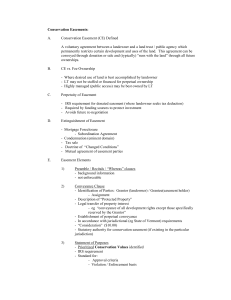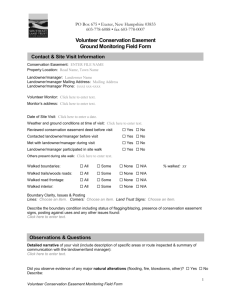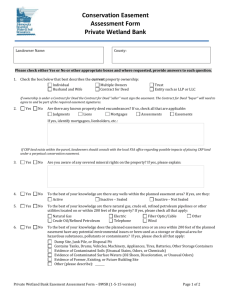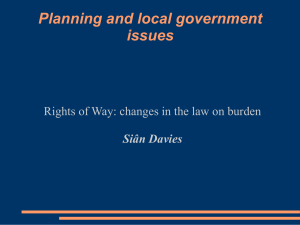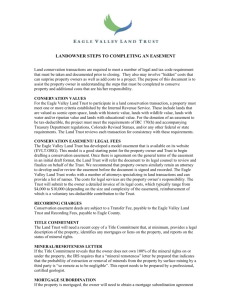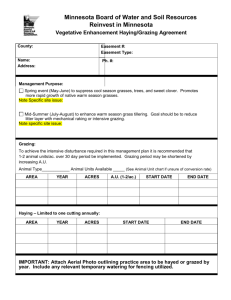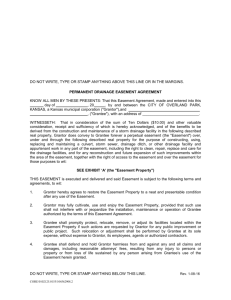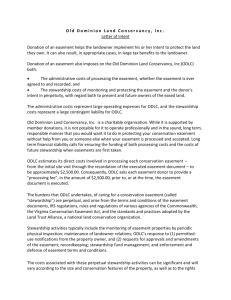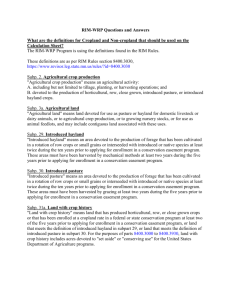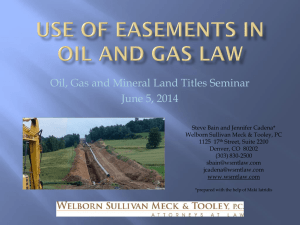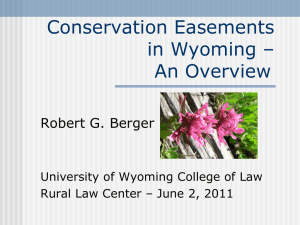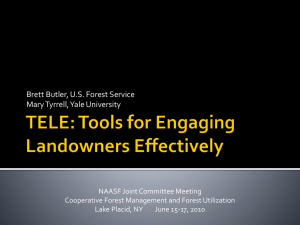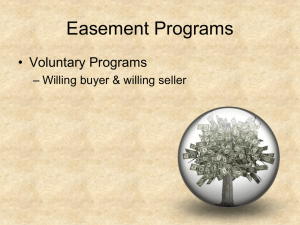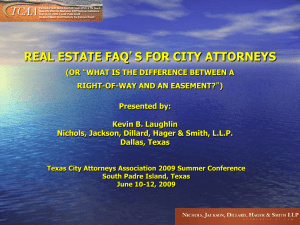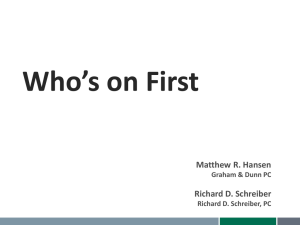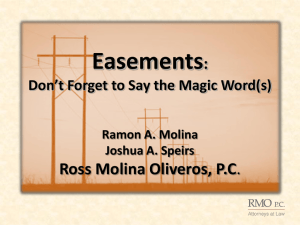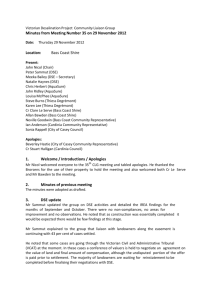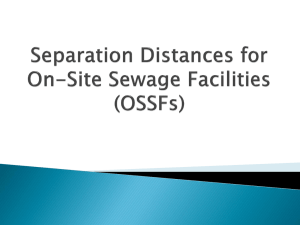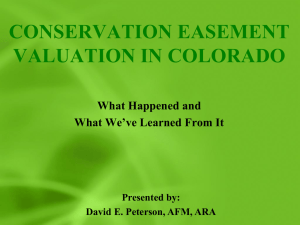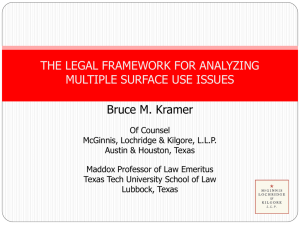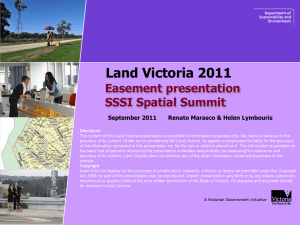Utility Right of Way and Easement Issues
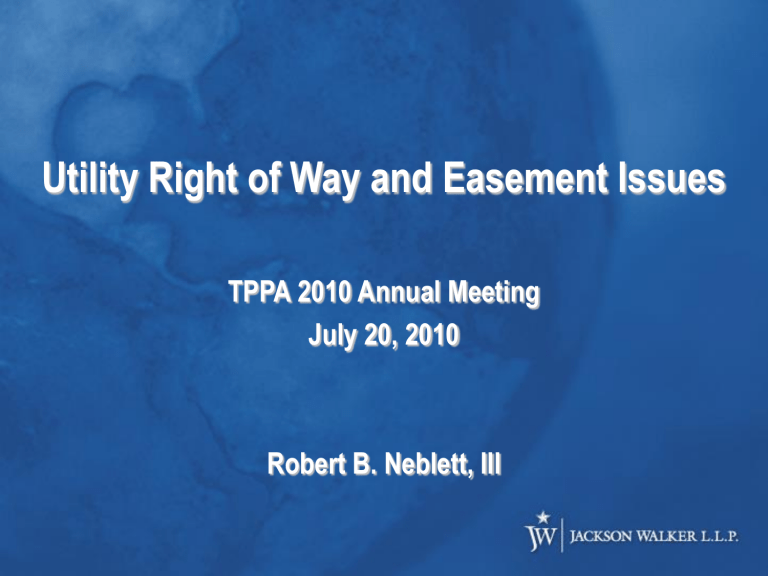
Utility Right of Way and Easement Issues
TPPA 2010 Annual Meeting
July 20, 2010
Robert B. Neblett, III
Case Studies
Example # 1:
• Landowner has 300 acre tract with a preliminary plat.
• Preliminary Plat “grandfathers” smaller lot sizes.
• Transmission Line crosses 30 lots.
• Can Landowner be compensated for loss of each lot on a per lot basis?
• What about loss of detention pond and of overall lots based on new zoning ordinances requiring larger lot sizes?
Transmission
Line Easement
Case Studies
Example # 2:
• Lessee sells manufactured homes along roadway where transmission line easement is being installed.
• Easement will require Lessee to set back product 100’ from roadway.
• Does Lessee have a compensable interest in condemnation?
• Can Lessee recover for lost profits based on reduced visibility?
• Can Lessee recover moving expenses for moving product out of the easement area? (§21.043 of the Texas Property Code)
Preliminary Survey Rights
• Utility with the power of eminent domain has the right to enter property to conduct preliminary survey.
• Lewis v. Texas Power and Light Co., 276 S.W.2d 950, 954
(Tex.App.—Dallas 1955, writ ref’d n.r.e.) (holding that the terms
“enter on” as used in Section 181.004 of the Texas Utilities
Code recognized the necessity of preliminary surveys and was intended to grant authority to conduct the same).
Cost Considerations
• Do you need access over the entire remainder in order to reach your Easement ?
• Will the landowner retain the right to place structures within the Easement area?
• Will the landowner retain the right to construct roads or change the grade of the
Easement area?
• What about the landowner’s trees within the easement?
• Are there other restrictions on the landowners right to use the Easement after construction of the project?
• Will you take action to restore the easement area as near as practical to its preinstallation condition?
• Will you indemnify the landowner?
Adequate Compensation
• Fair Market Value
• State v. Carpenter
• “…all circumstances which tend to increase or diminish present market value”
• But not “remote, speculative, or conjectural uses…not reflected in present market value”
• Broad terms have been further limited by subsequent case law.
Future Uses-Easement
• A Utility Is Limited in the Use of an Easement Only by Specific Language in the Easement
• In the absence of such specific limiting language, a utility can do anything with the estate necessary to accomplish the intended purposes of the easement
• Landowner can assume that the easement will be used to its fullest extent and may request greater compensation for the taking than if specific, limiting language were used*
Future Uses-Easement
Additional Lines
• Easement Language Can Be Carefully Crafted to Provide for Installation of Additional Lines
• Must expressly mention additional lines
• Boilerplate language regarding repair, removal, and replacement of a line is not sufficient to permit installation of additional lines
• Can describe route of future lines
• Should contain a means for determining compensation due for additional lines
Future Uses-Condemnation
City of Austin v. Cannizzo (Tex. 1954)
• Willing Buyer/Willing Seller Test excludes consideration of purely speculative uses but allows consideration of “all uses to which the property was reasonably adaptable and for which it was, or in
reasonable probability would become available, within a reasonable time”
Future Uses
Future Uses and the Concept of Reasonable Probability
Texas Electric Service Co. v. Campbell (Tex. 1960)
• Texas Supreme Court focused on evidence relating to the poor treatment of the remainder property during construction
• Construction crew littered the property with beer and whiskey bottles and rutted the remainder with truck tracks
• Evidence was offered to show de facto blanket easement and that remainder would be mistreated for life of the easement
Future Uses
Texas Electric Service Co. v. Campbell (Tex. 1960) cont.
• Court examined the rights sought and retained in the petition
• Petition awarded right of ingress and egress over and across defendant's adjoining land for the purpose of construction, inspection, maintenance and removal of such electric transmission line
• Texas Supreme Court held that evidence of poor treatment of the land as offered was merely a possibility, not a reasonable probability and was inadmissible
• Court further opined that unreasonable use of the right of ingress and egress could give rise to action in trespass
Future Uses
City of Pearland v. Alexander (Tex. 1972)
• Condemnation of 10 acres for sewage disposal plant
• Trial Court precluded evidence from City regarding intended use of the 10 acre tract
• Trial Court instructed jury that it was to presume that the City of Pearland will exercise its rights and use and enjoy the 10 acres to the full extent for a sewage disposal plant
Future Uses
City of Pearland v. Alexander (Tex. 1972)
• Supreme Court said instruction was an improper mandate to presume full use of the 10 acres
• In overturning the lower court, the Supreme Court held that:
“the City should not be required to pay severance damages on the basis of uses of the tract taken which are not at the time of the taking so reasonably probable as to be reflected in present market value and the jury should be permitted to give such weight to this factor as a prospective purchaser of the remainder tract would give”
Buying for a Business Necessity
Ford v. Destin Pipeline Co. (Miss. 2000)
• Pipeline condemnation case before the Mississippi
Supreme Court
• Landowner sought to introduce its previous sale of property to Koch-Gateway Pipeline Co. as a comparative sale
Buying for a Business Necessity
• Koch was in the process of constructing pipeline and had purchased tracts on either side of the Ford property
• Court upheld exclusion of sale because of the “business necessity created by the circumstances”
• “Hold Out Seller” not reflective of market value
Koch - Pipeline Ford Property Koch - Pipeline
Buying for a Business Necessity
• Hypothetical—
• “Utility A,” an entity without the power of eminent domain, pays landowner an arguably inflated amount in order to acquire the easement necessary to construct a transmission line along the route determined by the PUC.
• Should the purchase made by “Utility A” be admissible to show the fair market value of similarly situated properties in a condemnation case?
• What if other portions of the line had already been acquired along the route?
• Is “Utility A” a true willing buyer?
Recent Case Law
• Texas Midstream Gas Services v. City of Grand Prairie
• Power of Eminent Domain v. Police Power (Zoning)
• Midstream argued that entity with power of eminent domain was not subject to zoning ordinances so long as power of eminent domain was reasonably exercised.
• The Court disagreed, holding that while the police power could not be used to “zone out” or completely bar the intended public use (compressor station), entities with the power of eminent domain could still be subjected to non-site selection zoning ordinances.
• The effect of such logic resulted in the “zoning out” of Midstream’s compressor station.
